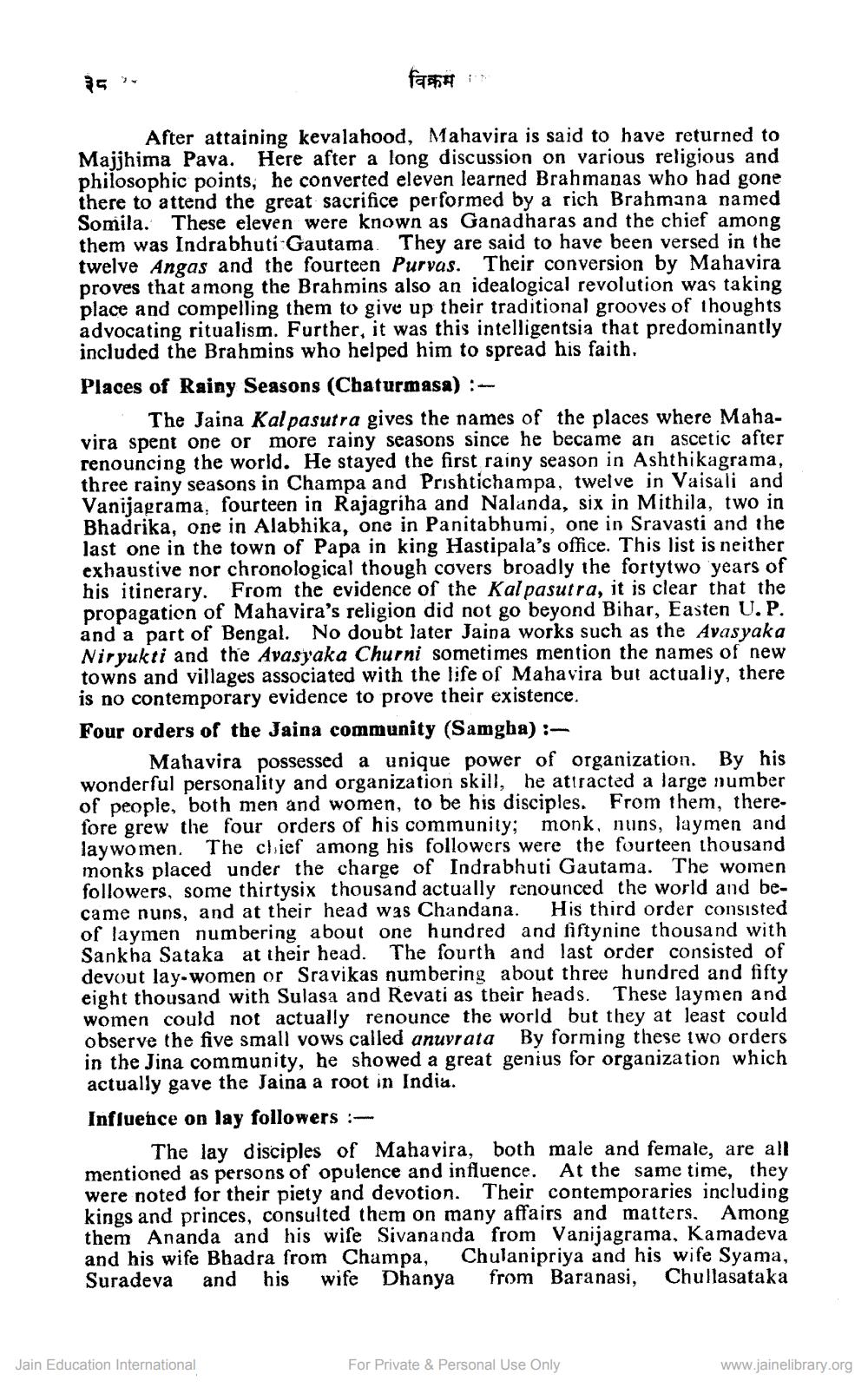________________
३८
विक्रम
After attaining kevalahood, Mahavira is said to have returned to Majjhima Pava. Here after a long discussion on various religious and philosophic points, he converted eleven learned Brahmanas who had gone there to attend the great sacrifice performed by a rich Brahmana named Somila. These eleven were known as Ganadharas and the chief among them was Indrabhuti Gautama. They are said to have been versed in the twelve Angas and the fourteen Purvas. Their conversion by Mahavira proves that among the Brahmins also an idealogical revolution was taking place and compelling them to give up their traditional grooves of thoughts advocating ritualism. Further, it was this intelligentsia that predominantly included the Brahmins who helped him to spread his faith.
Places of Rainy Seasons (Chaturmasa) :
The Jaina Kalpasutra gives the names of the places where Mahavira spent one or more rainy seasons since he became an ascetic after renouncing the world. He stayed the first rainy season in Ashthikagrama, three rainy seasons in Champa and Prishtichampa, twelve in Vaisali and Vanijagrama, fourteen in Rajagriha and Nalanda, six in Mithila, two in Bhadrika, one in Alabhika, one in Panitabhumi, one in Sravasti and the last one in the town of Papa in king Hastipala's office. This list is neither exhaustive nor chronological though covers broadly the fortytwo years of his itinerary. From the evidence of the Kalpasutra, it is clear that the propagation of Mahavira's religion did not go beyond Bihar, Easten U. P. and a part of Bengal. No doubt later Jaina works such as the Avasyaka Niryukti and the Avasyaka Churni sometimes mention the names of new towns and villages associated with the life of Mahavira but actually, there is no contemporary evidence to prove their existence.
Four orders of the Jaina community (Samgha) :
Mahavira possessed a unique power of organization. By his wonderful personality and organization skill, he attracted a large number of people, both men and women, to be his disciples. From them, therefore grew the four orders of his community; monk, nuns, laymen and laywomen. The chief among his followers were the fourteen thousand monks placed under the charge of Indrabhuti Gautama. The women followers, some thirtysix thousand actually renounced the world and became nuns, and at their head was Chandana. His third order consisted of laymen numbering about one hundred and fiftynine thousand with Sankha Sataka at their head. The fourth and last order consisted of devout lay-women or Sravikas numbering about three hundred and fifty eight thousand with Sulasa and Revati as their heads. These laymen and women could not actually renounce the world but they at least could observe the five small vows called anuvrata By forming these two orders in the Jina community, he showed a great genius for organization which actually gave the Jaina a root in India.
Influence on lay followers :
The lay disciples of Mahavira, both male and female, are all mentioned as persons of opulence and influence. At the same time, they were noted for their piety and devotion. Their contemporaries including kings and princes, consulted them on many affairs and matters. Among them Ananda and his wife Sivananda from Vanijagrama, Kamadeva and his wife Bhadra from Champa, Chulanipriya and his wife Syama, Suradeva and his wife Dhanya from Baranasi, Chullasataka
Jain Education International
For Private & Personal Use Only
www.jainelibrary.org




